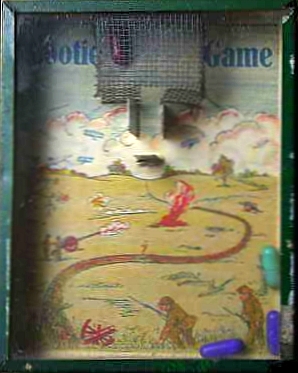The Game of Cootie facts for kids

Original box cover and game components, 1949
|
|
| Designer(s) | William H. Schaper |
|---|---|
| Publisher(s) | Hasbro |
| Publication date | 1949 |
| Players | 2 to 4 |
| Setup time | 2-4 minutes |
| Playing time | 10-20 minutes |
| Random chance | Entirely |
| Skill(s) required | Matching |
The Game of Cootie is a fun tabletop game for kids, played with dice and plastic parts. Two to four players try to be the first to build a bug-like creature called a "cootie." You collect different body parts like a body, head, eyes, and legs by rolling a die.
This game was created by William Schaper in 1948 and became very popular after it launched in 1949. Millions of games were sold! Over the years, different companies like Tyco Toys and Hasbro (through Milton Bradley) have owned and updated the game. In 2003, Cootie was even added to the Toy Industry Association's "Century of Toys List." The game is based on an older dice game called Beetle.
Contents
How to Play The Game of Cootie
The main goal of the original 1949 game is to be the first player to build a complete "cootie." You do this by collecting different plastic body parts. These parts include a body (which looks like a beehive), a head, antennae, eyes, a mouth (called a proboscis), and six legs.
Rolling the Die for Parts
You get body parts by rolling a die. Each number on the die helps you get a different part:
- Roll a 1 to get the cootie's body.
- Roll a 2 to get the cootie's head.
- Roll a 3 to get the antennae (also called feelers).
- Roll a 4 to get an eye.
- Roll a 5 to get the proboscis (mouth).
- Roll a 6 to get a leg.
Building Your Cootie
You must get the body first. After that, you need to get the head. Once you have the body and head, you can collect all the other parts in any order you want.
When you successfully get a part, you get to roll the die again! This gives you another chance to collect more parts. The first player to completely build their cootie wins the game.
What Does "Cootie" Mean?
The word "cootie" has an interesting history. It was used during World War I to describe bugs and lice that soldiers found in the trenches. The word might come from the Malaysian word kutu, which means head louse.
Today, in North American English, kids often use "cootie" to describe a pretend sickness or condition. It's often used in a playful way to keep boys and girls separate, like saying "You have cooties!" to avoid someone.
Other Games Like Cootie
Schaper's The Game of Cootie was not the very first game to feature an insect called a "cootie." Many games, mostly played with paper and pencil, were made after World War I.
For example, the Irvin-Smith Company made a game called Cootie Game around 1915. It was a small, hand-held game where you tilted capsules into a trap.
Later, in 1927, the J. H. Warder Company released Tu-Tee, and the Charles Bowlby Company released Cootie. These games were also about building a bug, but they were played with paper and pencils. In 1937, Rork's released The Game of Cootie, which was also a paper and pencil game. A similar paper and pencil party game called Beetle has been popular in Britain since the 1940s.
In 1939, Transogram published a game also called Cootie. It had a three-dimensional wooden bug that you put together in a special tray. However, Schaper's game was the first to use a fully three-dimensional, free-standing plastic cootie. This made it unique and helped it become so popular!
The Cootie Game's Legacy
Schaper's plastic cootie bug has become a well-known symbol. For many people who grew up in the "baby boomer" generation, it reminds them of their childhood.
In 2003, the Toy Industry Association recognized Cootie as one of the most memorable and creative toys of the 20th century. It was included on their "Century of Toys List," which features 100 important toys.


